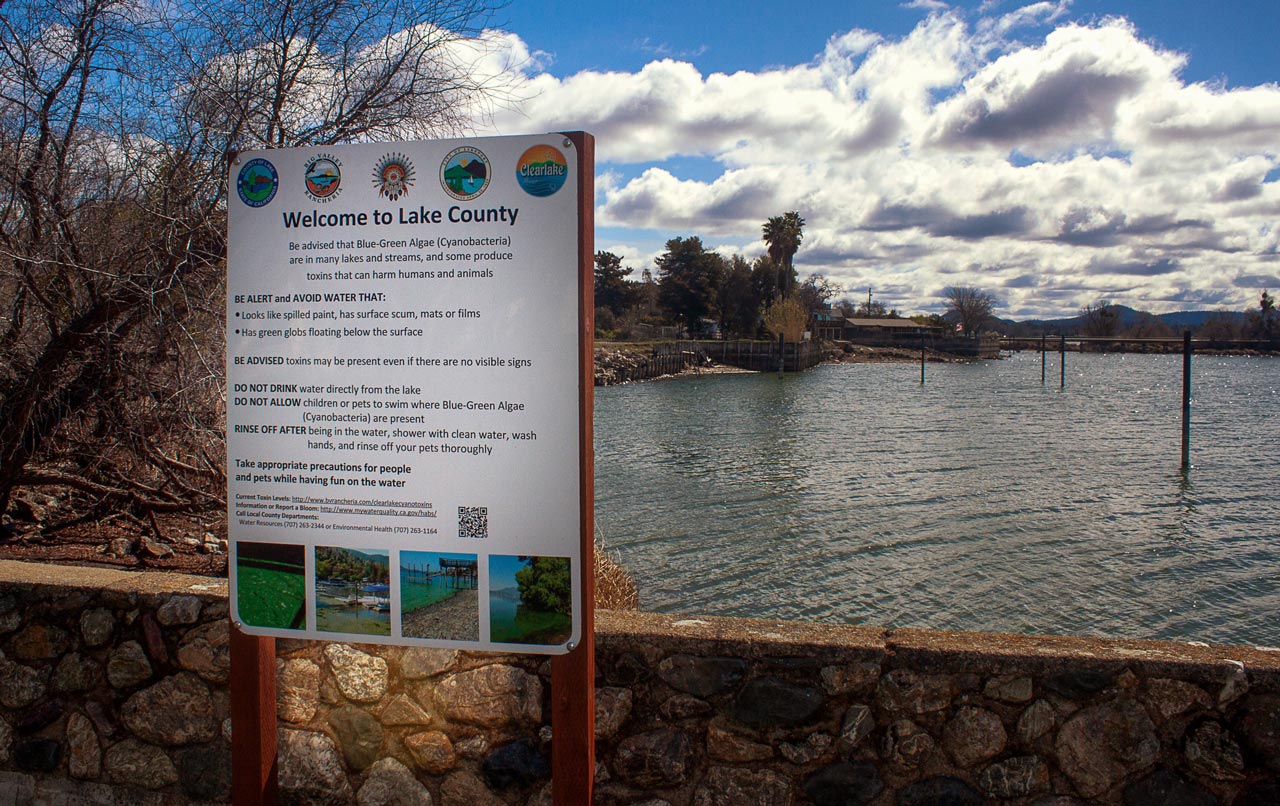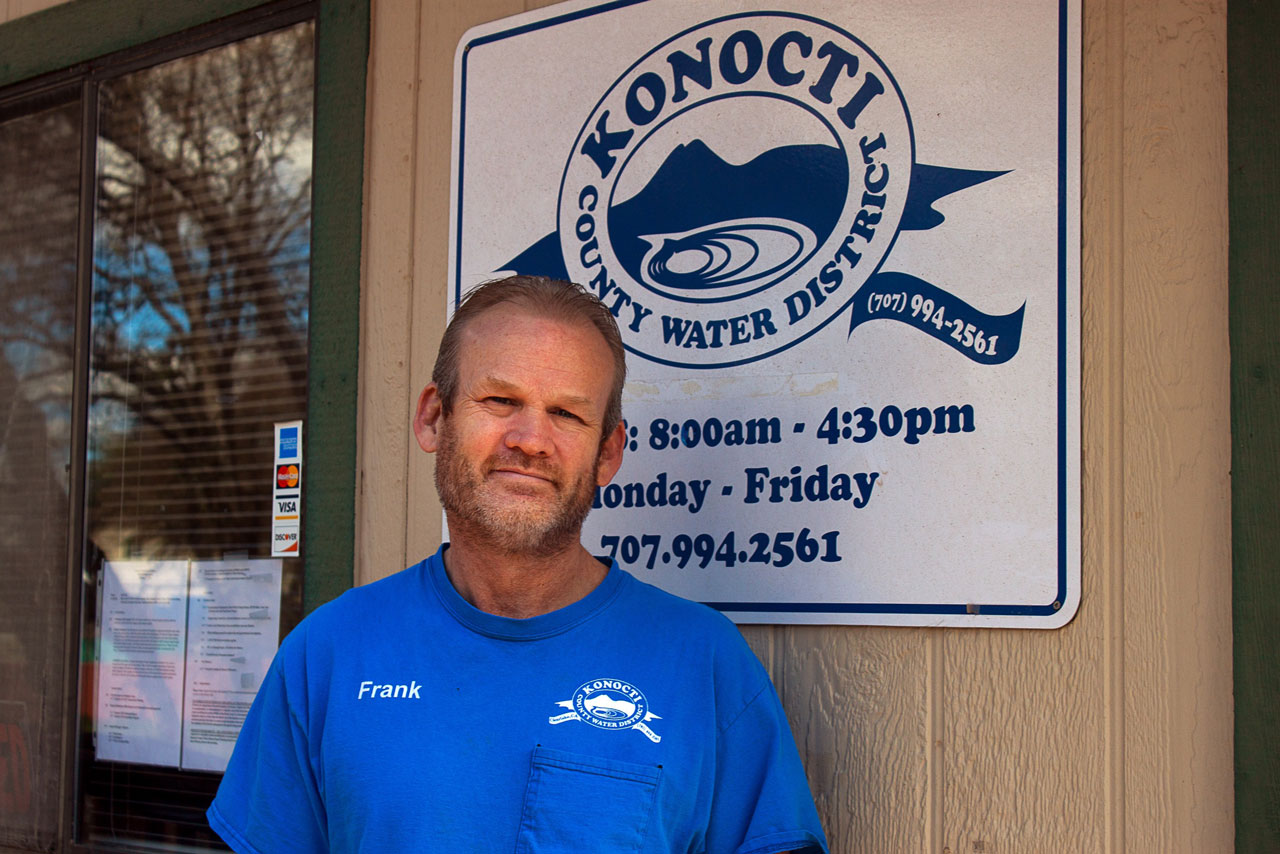May 4, 2021
By Brett Walton
Circle of Blue
Clear Lake sparkles on a sunny morning in March 2021, showing no evidence of the harmful algal blooms that tend to appear later in the summer.
CLEARLAKE, California — On a good day, usually in late winter and early spring, the magnificent waters of Clear Lake seem to live up to their name. Under the shadow of the volcano Mount Konocti, the oldest lake in North America and second largest in California sparkles in an array of blues while fishing boats ply the shallow nearshore, their anglers hoping to hook a trophy bass.
From his office two miles inland, Frank Costner knows that the lake’s waters also shelter a treacherous occupant — potentially toxic blooms of cyanobacteria. As general manager of Konocti County Water District, Costner is responsible for supplying drinking water from Clear Lake to 4,500 people who live in this region a two-hour drive north of San Francisco.
Costner has worked at the district for 32 years and he knows when lake conditions deteriorate. Mats of cyanobacteria ring Clear Lake during warm months, covering its crystal waters along the shoreline with paint-like swirls of green and white. When the wind comes from the west, foul odors waft toward his office.
“Kind of like dog poop,” Costner told Circle of Blue. “It’s pretty rough.” He searched for the right adjectives. “Poopy? I don’t know. Not like feces, per se — like human feces — but definitely like a dog poop smell. Decaying matter? It does smell bad.”
Not only an aesthetic affront, the harmful algal blooms are a threat to public health, recreation, and the local economy. For the 18 public water systems that draw from the lake the noxious blooms are something else: an operating hazard that is complicating their treatment processes and increasing the cost of providing clean water in one of the state’s poorest counties. For more than three decades, Costner has had a front-row seat.
“I’ve just seen the continual decrease in water quality, getting worse and worse as the years go by,” Costner said, reflecting on his career. “Water treatment is becoming harder and harder.”

Cyanobacteria blooms on Clear Lake in June 2020 resembled whorls of green and white paint.
Photo courtesy of Micah Swann
The degradation of Clear Lake and the steps Costner and other water managers are taking to deal with it, are a distillation of the turmoil that algae and cyanobacteria are taking across the United States and around the world. Climate change and nutrients flowing from the land are the primary ingredients of a toxic soup that is endangering lakes and rivers, and challenging public health and economies from California to China, from South Africa to France.
Reducing the threat, as Costner has learned, is expensive. State and federal water quality regulators, prodded by deteriorating conditions at Clear Lake and in other areas, are taking notice.
It all starts with cyanobacteria, sometimes called blue-green algae, ancient single-celled organisms that thrive in warm, nutrient-rich waters. Sometimes they produce toxins. For swimmers, the toxins can cause skin rashes and allergic reactions. Depending on which of the dozens of cyanobacteria species is present, consuming the toxins can lead to intestinal infections, liver damage, or nervous system impairments. Dogs have died from drinking toxin-laced water.
Front of mind for drinking water providers and regulators are recent contamination events that shook U.S. cities from coast to coast. Cyanotoxins from a harmful algal bloom in Lake Erie infiltrated Toledo’s drinking water system in 2014, leading city officials to warn more than 400,000 people not to use their tap water for days.
In 2018, residents of Salem, Oregon, found themselves in the same scenario when cyanobacteria proliferated in Detroit Reservoir and wound up in the city’s distribution system.
The conditions prevalent in Lake Erie’s western basin are also present in shallow Clear Lake, where lakebed sediments are fortified with centuries of accumulated phosphorus. A host of other sources around the lake — septic tanks, stormwater drainage, farm runoff, land erosion — add more phosphorus as well as nitrogen to the mix. Though acute cases of cyanotoxin poisoning in humans are rare, the last thing Costner wants is a crisis similar to Toledo or Salem to unfold for his customers. Fortunately his protections against such an event will soon be strengthened. His district broke ground in March on a near-total system overhaul, a $10 million renovation funded in full by a state grant because the district is classified as a severely disadvantaged community.
The project is expansive. A new water intake will extend 1,500 feet into the lake, nearly four times longer than the current pipe, in hopes of accessing water farther away from the blooms that cluster along the shore. The longer intake will ease the strain on the district’s pumps when the lake is low.
Because electric utilities in fire-prone California are now preemptively shutting off power on dry, windy days to reduce the odds that their transmission lines spark a wildfire, the district will be getting a backup generator, too. A power shutoff in Lake County in 2019 lasted four days, and Costner was able to run his aging generators only 14 hours a day before they needed a break.
Also in the grant package: a new pump house, a raw water line to the treatment plant, a charcoal and sand filter that doubles the filter capacity, a clear well where treated water is stored, and an upgraded computer control system.
The entire project is a response to the severe drought year of 2014, when lake levels plunged and the cyanobacteria grew from a nuisance to a threat, a situation that is poised to reemerge in the months ahead. California just experienced its third driest winter on record. Clear Lake is near the lows from 2014. So Costner is bracing for another grueling warm season.
“It’s going to be a really, really bad summer,” Costner said. “Let’s just hope it doesn’t get as hot as it’s been.”
Costner said that in March. As the calendar turns to May, and with Gov. Gavin Newsom having declared drought emergencies in the counties to the south and west of Lake County, a bad algae year on Clear Lake seems all the more likely.
Signs warning of the dangers of cyanotoxins are posted at public parks around Clear Lake.
Photo Brett Walton/Circle of Blue

The central geographic feature of Lake County, Clear Lake is the drinking water source for two-thirds of its 65,000 residents. Like Costner’s district, these are mainly small systems that serve a few thousand people.
The lake itself is a marvel, formed more than 2 million years ago at the intersection of three geologic fault lines. Indigenous groups have lived along its fertile shores for some 12,000 years. It’s also a degraded environment, not only from the harmful algal blooms and loss of 85 percent of its wetlands but also from a history of mercury mining that began just after the Civil War and lasted until 1957.
Clear Lake’s irregular shoreline is dimpled with bays and inlets. Add in shifting wind patterns due to the bulk of Mount Konocti and three distinct sub-basins, and you get a lake whose water and nutrient movements are highly variable, says Alexander Forrest of the University of California, Davis. Forrest is part of a state-funded research project that is mapping the lake’s water and nutrient flows in order to forecast blooms and, possibly, design interventions to prevent them.
The unusual hydrology has a direct effect on the cyanobacteria blooms. They tend to concentrate in the lake’s smaller eastern sub-basins, the Oaks Arm and Lower Arm, which appear from above like the pincers of a crab claw. Because of the clustering, not all water systems around Clear Lake have had the same experience with algae.
Buckingham Park Water District is on a peninsula that juts into the middle of the lake. Ahimsah Wonderwheel, the general manager, told Circle of Blue that the district’s location has protected it from being overwhelmed by blooms. The district has been voluntarily testing its water for cyanotoxins for three years, but it has not needed to install any new treatment equipment, even though there are no California or federal drinking water standards for cyanotoxins that would require him to do so.
Still, the toxins aren’t the only headache for drinking water operators. The blooms themselves — their soupy biomass — are enough to cause problems. Scott Harter is the special districts administrator for Lake County, which manages two small treatment facilities that draw from the lake. Harter said that the blooms tax the water treatment system, increasing operating and electrical costs because filters have to be flushed more frequently.
Costner also has seen his operating costs rise. The algae build up in his treatment works, producing more sludge that the district has to discard. Each truck load he sends to the recycling center costs him $250. Then there are the increased costs of chemicals and labor, plus more frequent filter changes. Carbon filters that used to last five to seven years are now being replaced in half that time. Though Costner could not give an exact figure, the costs add up.
“Whether or not cyanobacteria are producing toxins, just the presence of cyanobacteria themselves can cause all of these issues in treatment processes,” explained Stefan Cajina of the state Division of Drinking Water. “It is a tremendous challenge for these systems. They do have to deal with it out of their own budgets and operations staff. I can tell you that many of these systems have been under a lot of strain to deal with this in the summer and fall months.”
Because of the harmful algal blooms “water treatment is becoming harder and harder,” says Frank Costner, the general manager of Konocti County Water District, which supplies drinking water to about 4,500 people. Thanks to a $10 million state grant, the district is overhauling its water system in response to the blooms.
Photo Brett Walton/Circle of Blue

The harmful algal blooms in Clear Lake have caught the attention of Cajina and other state regulators. Starting this summer, the State Water Resources Control Board is requiring the 18 drinking water providers around the lake to test their treated and untreated water for microcystins, which is one of the cyanotoxin groups. It is the first time the Water Board has issued such an order anywhere in the state.
“We’re doing it in Clear Lake because the magnitude of the problem is so apparent there and well documented,” Cajina told Circle of Blue. “It’s one of the few water bodies in the state where we can say with some certainty that just about every year in the summer and fall months we’re going to see significant levels of microcystins.”
In 2018, the Division of Drinking Water found that all public water systems around Clear Lake had treatment systems that were effective barriers against cyanotoxins, but Cajina said the new order will provide more data than that one-time snapshot.
State officials are not the only ones concerned. The U.S. Environmental Protection Agency published health advisories in 2015 for two cyanotoxins: cylindrospermopsin and microcystins. Health advisories are unenforceable guidelines that function as a warning signal to water utilities. Below the exposure level, which is measured in days, years, or a lifetime, no health damage is expected to occur. Utilities are not punished if they exceed the advisory as they would be for formal regulations.
To inform potential regulatory standards that utilities would be required to achieve, the EPA ordered more than 3,400 drinking water providers nationwide to look for the toxins. From 2018 to 2020, these utilities tested their treated water for nine cyanotoxins as well as for total microcystins. Only seven systems reported microcystins levels above the health advisory.
Though few systems had toxins survive the treatment process, the threat still lurks in rivers and lakes. Nutrient levels in waters and soils are already high, and warming temperatures are an added boost to cyanobacteria, says Hans Paerl of the UNC Chapel Hill Institute of Marine Sciences.
“They like global warming,” Paerl, one of the country’s foremost cyanobacteria researchers, told Circle of Blue. “They do better when it’s warmer because their optimal growth temperatures are relatively high. Everything you can think of that we’re currently discussing about climate change pretty much benefits them.”
Costner has witnessed these changes, too. His backyard weather station recorded between 6 and 7 inches of rain last year. Usually the area gets more than 25 inches. Clear Lake is nearly as low today as it was in 2014, when the full force of drought fell upon the state.
Though he is apprehensive about the coming summer, Costner is hopeful that the system renovation, when it is completed in 2023, will provide the district and his customers with better water — his family included.
“I live in my district, I drink my water,” he said. “My grandchildren and my children drink the water. I want to have safe water. I want my community to have safe water.”
This piece is part of a collaboration that includes the Institute for Nonprofit News, California Health Report, Center for Collaborative Investigative Journalism, Circle of Blue, Columbia Insight, Ensia, High Country News, New Mexico In Depth and SJV Water. It was made possible by a grant from The Water Desk, with support from Ensia and INN’s Amplify News Project.